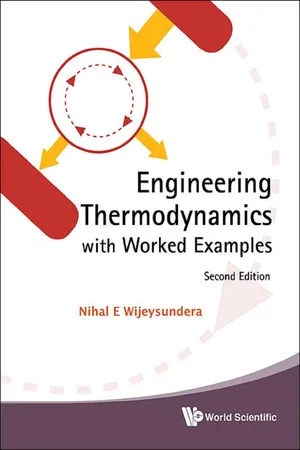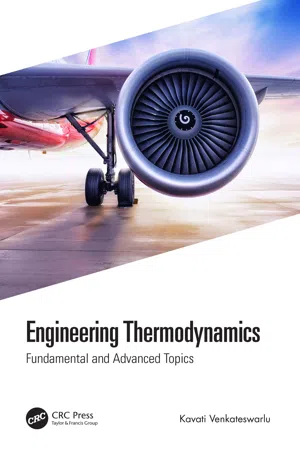Physics
Work Done
Work done is a measure of the energy transferred when a force acts on an object and causes it to move. It is calculated by multiplying the force applied by the distance over which the force is exerted. In physics, work done is a crucial concept for understanding the transfer and transformation of energy in various systems.
Written by Perlego with AI-assistance
Related key terms
Related key terms
1 of 4
Related key terms
1 of 3
10 Key excerpts on "Work Done"
- eBook - ePub
Physics of Cryogenics
An Ultralow Temperature Phenomenon
- Bahman Zohuri(Author)
- 2017(Publication Date)
- Elsevier(Publisher)
These may be called energy transfer or energy interactions and they bring about changes in the properties of the system. Positive work occurs when the system transfers energy to its surroundings by some mechanical or electrical process. Positive heat transfer occurs when the surroundings transfer thermal energy to the system. Normally a temperature difference is the driving potential that moves thermal energy into or out of a system.4.2. Definition of Work
The formal definition of work is “a force acting through a distance.” When a system undergoes a displacement due to the action of a force, work is taking place and the amount of work is equal to the product of the force and the displacement in the direction of the force. The term work is so common with many meanings in the English language that it is important to be very specific in its thermodynamic definition.4.2.1. Work Is Done by a Force as It Acts Upon a Body Moving in the Direction of the Force
If the force acts, but no movement takes place, no work is done. Work is performed by the expanding exhaust gases after combustion occurs in a cylinder of an automobile engine as shown in Fig. 4.1 . In this case the energy produced by the combustion process can be transferred to the crankshaft by means of the connecting rod, in the form of work. Therefore, the work can be thought of as energy being transferred across the boundary of a system, the system being the gases in the cylinder.A similar concept is the Work Done in the turbine to generate electricity in a nuclear power plant. The gas pressure rotates the turbine blades producing a torque that turns a generator. Thermal energy is transferred from the reactor core to the steam generator in the first loop. The second loop then uses this steam to drive the turbine. See Fig. 4.2 - eBook - ePub
- John Bird(Author)
- 2019(Publication Date)
- Routledge(Publisher)
Science and Mathematics for Engineering. 978-0-367-20475-4, © John Bird. Published by Taylor & Francis. All rights reserved.21.1 Introduction
This chapter commences by defining work, power and energy. It also provides the mid-ordinate rule, together with an explanation on how to apply it to calculate the areas of irregular figures, such as the areas of ship’s water planes. It can also be used for calculating the Work Done in a force-displacement or similar relationship, which may result in the form of an irregular two-dimensional shape. This chapter is fundamental to the study and application of dynamics to practical problems.If a body moves as a result of a force being applied to it, the force is said to do work on the body. The amount of Work Done is the product of the applied force and the distance, i.e.21.2 Work
work done = force × distance moved in the direction of the forceThe unit of work is thejoule* , J,which is defined as the amount of Work Done when a force of 1 newton acts for a distance of 1 m in the direction of the force. Thus,1 J = 1 N mIf a graph is plotted of experimental values of force (on the vertical axis) against distance moved (on the horizontal axis) a force/distance graph or work diagram is produced. The area under the graph represents the Work Done.For example, a constant force of 20 N used to raise a load a height of 8 m may be represented on a force/distance graph as shown in Figure 21.1 - eBook - ePub
Introductory Physics
Summaries, Examples, and Practice Problems
- Michael Antosh(Author)
- 2023(Publication Date)
- CRC Press(Publisher)
Energy, and WorkDOI: 10.1201/9781003005049-66.1 Introduction: Motion Has Energy
So far, we’ve looked at motion by describing the way it happens (Chapters 2 –3 ) and by looking at the forces that cause it (Chapters 4 –5 ). We’ll now look at motion by talking about energy – something that can go into and out of an object as it moves.There are many types of energy in the world – for example, the electrical energy that powers computers, phones, lights, cars, etc. In this chapter we will talk specifically about three types of energy that relate to motion: kinetic energy, potential energy, and mechanical energy. But first, we’ll start by talking about the physics concept of work.6.2 Work by a Constant Force
In physics, we say that a force does work when it helps to move an object.In this section, we’ll do a simple case – a constant (non-changing) two-dimensional force F on an object that moves by a two-dimensional displacement Δx. (F and Δx are bolded because they are vectors; remember from Chapters 2 and 3 that displacement is a change in position.) In this case, the amount of Work Done by the force F is:W = F∙Δx∙cos(θ)(6.2.1)In this equation, W is the work, F is the magnitude of force F, Δx is the magnitude of vector Δx, and the angle θ is the angle between the direction of F and the direction of Δx.Note that the work is not a vector. None of the work or energy quantities coming up in this chapter are vectors. The units of work are N∙m, usually said as “Newton meters”. In the equation, one term (force) has units of Newtons, and it is multiplied by a term with units of meters (Δx). The cosine term has no units.The cosine term in Equation 6.2.1 can make the work positive, negative, or zero.- cos(θ) is a negative number if the angle θ is between 90 and 180 degrees. When the force is opposite to the motion (like with kinetic friction), θ = 180 degrees and cos(180°) = –1.
- cos(θ) = 0 when θ = 90 degrees. This means that when a force is 90 degrees from the motion (also called perpendicular to it) it is not doing work on an object.
- eBook - ePub
- Nihal E Wijeysundera(Author)
- 2016(Publication Date)
- WSPC(Publisher)
chapter 1 on the attributes of properties, we conclude that the kinetic energy is a property of the body.To evaluate the Work Done on the body, using the left hand side of Eq. (3.2) , we need to know how the force F varies with the displacement x . Therefore, the Work Done by the force is, in general, path-dependent. However, for certain forces like the gravitational force, the Work Done in moving the body from one point to another is independent of the path followed. Such a force is called a conservative force .The vector form of the expression for Work Done can be written aswhere F and are the force and position vectors respectively. The work, W however, is a scalar quantity. Note that the common units of work may be expressed as: [W ] = Nm (Newton-meter) = J (Joule).3.2Work Interactions in Thermodynamics
The interactions of a thermodynamic system with its surroundings occur at the system boundary. These interactions are usually the result of pressure forces, electrical currents, surface tension forces and others. For a concise formulation of the laws of thermodynamics we categorize all boundary interactions under two broad headings. These are called work interactions and heat interactions .3.2.1Criterion for a work interaction
It is possible to develop a criterion to determine unambiguously the nature of the interaction at a system boundary. A given boundary interaction is a work interaction if its sole effect on the surroundings could be resolved into the raising or lowering of a weight. In other words we should be able conceive of a device which when coupled to the given system (i) raises or lowers a weight in the surroundings using the same interaction, and (ii) leaves no other permanent effect on the surroundings. The concept is best illustrated using the piston-cylinder arrangement that has a gas, and an electrical heating element connected to a battery, as shown in Fig. 3.2(a) .Consider the gas as our system. As the gas expands due to heating, the piston will move up pushing the outside ambient air. There are two different boundary interaction that could be clearly identified. These are (i) the Work Done by the gas in raising the piston with the weight while pushing the outside air and (ii) the flow of electrical energy across the sections of the wire where they cross the system boundary. - eBook - ePub
- Jeffrey W. Bloom(Author)
- 2010(Publication Date)
- Routledge(Publisher)
This loss of energy to systems is important in our understandings of energy in ecological systems, which was discussed in Section 3. Work and Power Work, from a physics perspective, involves using energy to apply a force to move some object a specific distance. Work equals force times distance: (W = f × d). The most common unit that is used for work is a joule, named after James Joule (1818–1889), a British physicist: 1 joule = the force of 1 Newton applied over a distance of 1 meter. Work is involved in our walking and running, in driving, moving furniture, lifting weights, and all kinds of activities that require moving some sort of object a distance in some direction. • Example: You push a box 5 m across the floor using a 20 Newton force: REMEMBER: 1 Newton = mass × 1 m/sec 2 20 N × 5 m = 100 joules Let’s say this took you 6 seconds to complete. If you repeated this task in 3 seconds, it will still be the same amount of work, but you will have used twice as much power, which brings us to the next concept. Power has to do with increasing the speed at which work is done. The term watt (named after James Watt, a Scottish inventor 1736–1819) is used as the unit for power that has to do with the speed with which work is done. Although we commonly associate the term “watt” with the power of light bulbs, it is the scientific term used for power in general. The other term commonly used to describe power, especially in cars and tools with motors, is horsepower. Interestingly, the term “horsepower” was also coined by James Watt. He found that when experimenting with horses, his horses were able to pull 22,000 lb of coal the distance of 1 ft in 1 minute, but later changed it to 33,000 ft-pounds per minute. One horsepower is equivalent to the electrical horsepower of 746 watts - No longer available |Learn more
- Robert A. Pelcovits, Joshua Farkas(Authors)
- 2023(Publication Date)
- Barrons Educational Services(Publisher)
We have discussed qualitatively how the sign of work is related to the change in an object’s speed (forces that exert positive work increase speed, forces that exert negative work decrease speed, and forces that exert zero work do not affect speed). Now we would like to define this relationship mathematically. We start with the definition of work and integrate to obtain the total work:If the net force is not constant, we must first express the integrand in terms of one variable and its own differential (this is similar to separating variables when solving air resistance problems in the last chapter). In this case, the manipulations are a little more tricky:Rearranging, Now the right side is ready to integrate: It is composed of two integrands, each of which is defined by a different variable and its own differential.Given the definition of speed as , this can be rewritten asWe are thus led to define a new quantity, the kinetic energy:Definition of kinetic energySimilar to work and other forms of energy, kinetic energy has units of joules (J = N · m = kg · m2 /s2 ).Work–Kinetic Energy Theorem
Now we can appreciate the physical significance of work rather than viewing it simply as a mathematical definition: Work is the change in an object’s kinetic energy due to the action of a given force.Work–kinetic energy theoremThis is the first and most fundamental of a number of equations we will soon derive relating various types of work and energy. This theorem is a restatement of Newton’s laws, and it is always valid.TIP This theorem is another way of stating Newton’s second law.Example 4.2A force acts on an object of mass 2 kg as it moves from x = 0 to x = 5 m. Given that the object is at rest at x = 0,(a)Calculate the net work. (b)What is the final speed of the object?Solution(a)(b)Conservative and Nonconservative Forces
The Law of Conservation of Energy
Energy is never created or destroyed; it merely changes form. The total energy of an isolated system is constant when all forms of energy are accounted for (e.g., sound, light, heat, KE). - eBook - ePub
- Sir James H. Jeans(Author)
- 2013(Publication Date)
- Dover Publications(Publisher)
Consider, for example, a hammer striking a nail. The reaction between the hammer and nail is a force in the direction opposite to that of the motion of the hammer, and this ultimately brings the hammer to rest. Again, when a particle is projected vertically upwards, its weight after a time reduces it to rest, after which of course it falls back to the ground.By the time that the moving body has been reduced to rest the point of application of the force, which has moved with the moving body, has moved through a certain distance. Thus a certain amount of work has been done by the moving body. We are thus led to the conception of the motion of a body possessing a capacity for doing work.For instance, in the previous examples, the motion of the hammer has driven the nail into position, and the motion of the particle projected into the air has raised it to a certain height above the earth’s surface.139. Let us suppose that a particle moving with velocity v is opposed by a force P (in absolute units) acting in the direction opposite to that of the motion of the particle. Let the particle describe a distance ds in opposition to this force in time dt , and let its velocity change from v to v − dv in this time. The particle then has a retardation in the direction of its motion, or, what is the same thing, an acceleration in the direction in which P is acting, so that by the second law of motionThe Work Done by the particle in moving the distance ds in opposition to the force P isor, since is the same as the velocity v of the particle,P ds = mv dv .Integrating, we find that the whole Work Done by the particle before being reduced to rest is(36)Since P has to be measured in absolute units (cf. § 22), it follows (§ 111) that the work mv 2 will also be measured in absolute units.Thus whatever the magnitude of the force opposing the motion of a particle, the work performed by the particle before being reduced to rest is the same, namely mv 2 absolute units of work.The quantity mv 2 (measured in absolute units ) is called the kinetic energy of a moving particle. It is equal. to the amount of work which can be performed by the particle before being reduced to rest. - eBook - ePub
- Robert Lambourne(Author)
- 2019(Publication Date)
- CRC Press(Publisher)
x , the Work Done isSo the Work Done by a constant force that is aligned with a given displacement, is equal to the product of the force and the displacement.W =(2.3)F xs x.Notice that the Work Done by a constant aligned force depends only on theproduct Fx sx .This means that a large force acting over a small displacement can change the energy of a body just as much as a small force acting over a large displacement, provided the productFx sxis the same in both cases. Also notice that the formulaW = Fx sxapplies whethersxandFxare positive or negative. If the force and displacement are in opposite directions, then the Work Done by the force is negative, and it will cause a reduction in the energy.Another point to note about work that follows directly from Equation 2.3 , is that an SI unit of work is the newton metre (N m). However, since the Work Done on a body is equal to the energy transferred to that body (Equation 2.2 ), it is also the case that work can be measured in joules (J). The joule is the more conventional unit to use, but it is the case that 1 J = 1 N m since 1 N = 1 kg m s−2 , while 1 J = 1 kg m2 s−2 .You will be aware, from everyday experience, that simply supporting a weight without displacing it can be quite tiring. You may therefore find it odd that Equation 2.3 implies that no work is done in such a situation, sincesx - eBook - ePub
Engineering Thermodynamics
Fundamental and Advanced Topics
- Kavati Venkateswarlu(Author)
- 2020(Publication Date)
- CRC Press(Publisher)
Free Expansion: Work transfer is basically a boundary phenomenon that is recognized at the boundary of the system. Free expansion is the expansion of gas against the vacuum. If we consider a gas separated from the vacuum by a partition, after the partition is removed, gas escapes to fill the entire volume. The work is said to be done when a force acts through a distance. In this case, though there is a change in the volume, Work Done will be zero, disregarding the Work Done for removal of the partition, since the force applied is zero though there is a displacement.(3.38)∫ 1 2δ W = 03.7 Relationship between Heat and Work
Heat and work are the two means of energy transfer between a system and its surroundings and they are the two forms of energy. Certain similarities between the two are given below.- Both heat and work are boundary phenomena and occur at the boundaries of a system as they cross the boundaries.
- We can neither store heat nor work in a system, though systems possess energy.
- Both are path functions, that is, the change of work or heat in a change of state depends on the path followed during a process.
- Both heat and work, unlike properties such as energy and entropy, are associated with a process, not a state.
In engineering thermodynamics, the focus will be on work-producing devices such as internal combustion engines and turbines. Hence, it is always suitable to consider such work as positive. That is, the Work Done by the system is positive, and the Work Done on the system is negative. In certain cases, however, it is convenient to regard the Work Done on the system to be positive. To reduce the possibility of misunderstanding in any such case, the direction of energy transfer is shown by an arrow on a sketch of the system, and work is regarded as positive in the direction of the arrow. It is necessary to know how the force varies with the displacement. This brings out an important idea about work. - eBook - ePub
Biomechanics of Dance
Applications of Classical Mechanics
- Melanie Lott(Author)
- 2023(Publication Date)
- De Gruyter(Publisher)
Metabolic energy will then be covered, including factors that contribute to the rate at which it is used, how metabolic energy usage is measured experimentally, and factors that contribute to efficient (or inefficient) metabolic energy use. 7.1 Mechanical work 7.1.1 Mechanical Work Done by a force Let’s begin by choosing our system of interest to be a single dancer and use our simplest physical model : a point particle at the CM. An external force F → acting on a particle as it moves an infinitesimal displacement d x → does an infinitesimal amount of work, defined by the scalar product d W = F → · d x →, since it is the component of F → parallel to d x → that contributes to the Work Done. d W = F cos ϕ d x = F ∥ d x where ϕ is the angle between F → and d x →. To find the total Work Done by the force over a finite displacement from point A to point B, we must add up (i. e., integrate) all of the infinitesimal bits of work along the path. (7.1) W = ∫ A B F → · d x → This is a line integral which depends on the path taken from points A to B, and the force can in general be non-constant (e. g., as is most often the case for the GRF). In Cartesian coordinates eq. (7.1) can be written as W = ∫ F x d x + ∫ F y d y + ∫ F z d z. For 1-D motion (e. g., vertical, or z -direction motion), the problem is simplified to W = ∫ F z d z and further simplified if the force F z is constant, W = F z Δ z = F z (z B − z A). Although both F → and d x → are vectors, their dot product, work, is a scalar with units of Joules (1 N m = 1 J). Work Done by a force can be positive or negative depending on whether the force has a component parallel or anti-parallel to the displacement
Index pages curate the most relevant extracts from our library of academic textbooks. They’ve been created using an in-house natural language model (NLM), each adding context and meaning to key research topics.
Explore more topic indexes
Explore more topic indexes
1 of 6
Explore more topic indexes
1 of 4









